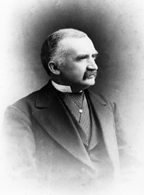Distinguished Faculty AwardCHARLES DELAMATER VAIL '59

CHARLES DELAMATER VAIL '59
Member of the faculty
1872-1909
Charles D. Vail was born in Goshen, New York in 1837 to Jacob Arnot Vail and Halia Ann (Smith) Vail. He attended Hobart College from 1855-59 and was the first recipient of the White Essay Prize awarded to the student with the best essay during the year. He also was Phi Beta Kappa at Hobart, and after graduation taught for several years at both Seneca Falls and Geneva High Schools.
He received an M.A. from Hobart in 1862, and started his career at Hobart in 1869 as a tutor. In 1872, he joined the faculty as Professor of English and Rhetoric and Librarian. From the year he entered his beloved Hobart until the year he retired (1909), he missed only one commencement. This demonstrates his devotion to Hobart as well as providing a microcosmic history of the College where many members of the faculty dedicated their lives to the school.
Hobart’s “Chesterfieldian” served the College in many capacities: as registrar, librarian, director of alumni affairs, historian of the College and New York State affairs, author, speaker at numerous events related to Hobart, participant on countless committees, and Horace White Professor of Rhetoric, Elocution, and English Literature.
When the duties of librarian caused him to stop classroom teaching in 1885 (that year marked the opening of Demarest Library following the burning of the middle building which had housed the library), his role as a teacher simply took on a different mantle. From the beginning all the librarians at these Colleges have had faculty status and the written evidence bears this out in Vail’s case; furthermore, he never actually stopped teaching in the classroom, although after 1885 his classroom teaching was sporadic, filling in for absent colleagues and teaching a reduced course load necessitated by his many other full-time duties.
The many references to Professor Vail in the Hobart Herald attest to his constant presence and contribution to campus life. One of the most significant contributions lies in his pioneering concepts of what is now considered a modern English department. Professor Turk, in a 1921 editorial upon Professor Vail’s death wrote about how Vail, along with close colleagues at Columbia College, Yale, and others in England, “believed that the English language and literature should be taught with the same ideals and objects as had long inspired instruction in Greek and Latin. The idea was a new one...and not a few distinguished graduates of his day have given as writers and preachers brilliant illustrations of the soundness of his views.”
He and his second wife, Helen Houghton, became great benefactors to the Colleges. Professor Vail died in 1921 after 49 years of service to Hobart.
